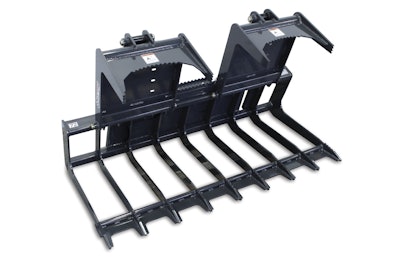 Photo: Arrow Material Handling Products
Photo: Arrow Material Handling ProductsThe Golden Age of the grapple is upon us…okay, so maybe that’s a bit of an over-statement. However, brush and root grapples have earned their place as a mainstay in many attachment collections. Their versatility and ability to attach onto tractors, loaders and skid steers alike have made this grapple a very popular tool.
In order to keep up with demand, many manufacturers have either upgraded or introduced new brush and root grapples to their product offerings. And while options are always great, the variety of features, materials used, specifications and designs can be a bit confusing.
Here’s what you need to know when purchasing a brush and root grapple.
The arms
Grapple arms, sometimes referred to as the grapple lid, comprise the top portion of the grapple design and are what makes a grapple, a grapple. Brush and root grapples most commonly feature one of two popular grapple arm designs: single or dual arm.
Single arm
Single arm grapples commonly feature a light-duty, single-cylinder hydraulic construction made for smaller, more compact brush. There are heavy-duty single arm grapple options made to provide more force for heavier more uniform brush. However, both designs struggle with bulky loads.
- Arm fully, or nearly, extends the length of the grapple
- Best for smaller, more compact brush
- Not ideal for non-uniform loads like limbs or logs
Dual arm
Dual arms are the most popular solution. The use of two independent arms allows for an equal amount of force with the ability to handle non-uniform bulky brush. This design is favored in the construction of heavy duty brush and root grapples.
- Two independent hydraulic grapple arms
- Great for bulky non-uniform loads like logs and limbs
The tines
Grapple tines support the load being carried like a bucket, but without edge plates or a solid bottom. This allows the grapple to easily carry brush, sticks and logs while leaving dirt, leaves and other smaller debris behind. Be careful though; not all tines are created equal. Here are some quick tips.
Tine spacing
Tine spacing refers to the amount of space between each tine. The correct solution usually comes down to the type of debris being handled.
- Less space (3-5 inches) between tines is better for compact debris
- More space (10-20 inches) is best for bulky loads like logs or large limbs
- Spacing between (6-9) inches is a good middle ground
Reinforcement
Some brush and root grapples feature a reinforcement rod running the width of the attachment to support the tines as they dig into the ground. This is largely a benefit because of the following:
- Protects against tines bending when pushed against rocks, roots and stumps
- Increases lifespan of grapple
Steel
The quality of steel in a brush and root grapple is critical, especially when in heavy use. An initial investment in a grapple made from heavy-duty steel saves money in the long run, as it will last longer, need fewer repairs and maintain its value for years to come. The differences between light and heavy duty steel are:
Light duty
- Feature grade 30 (or lower) 3/8” or thinner steel
- Lightweight (weighs 700 lb or less)
- Low capacity (under 1750 lb)
Heavy duty
- Feature grade 50 ½” or thicker steel
- Heavier (weighs 900 lb or more)
- High capacity (over 2500 lb)
The little things that count
Greasable hinge pins – The movement of the jaw as the grapples open and close is kept in place using a hinge pin. In many grapples, this pin makes direct contact with the hinge, eventually causing wear, and increased friction decreasing the lifespan of the attachment. A greasable hinge pin ensures the hinge does not come in contact with the pin.
Hydraulic cylinder guards – Brush and root grapples are subject to a lot of high impacts and abuse, and that abuse can be damaging to the hydraulic cylinders. In order to protect the cylinders from damage, some manufacturers include cylinder guards.
Hoses and couplers – Not all manufacturers include hydraulic hoses and couplers with their brush and root grapples. Ensure your quote includes this feature.
EDITOR’S NOTE: This was written by Mitch Salva with Arrow Material Handling Products. Arrow Material Handling Products has been a leading supplier of replacement forks for over 40 years.










